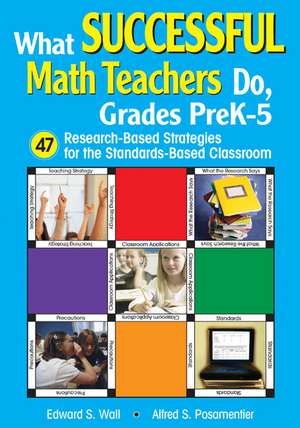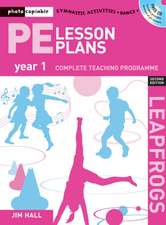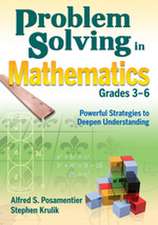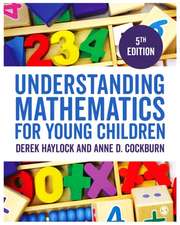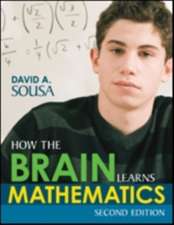What Successful Math Teachers Do, Grades PreK-5: 47 Research-Based Strategies for the Standards-Based Classroom
Autor Edward S. Wall, Alfred S. Posamentieren Limba Engleză Paperback – noi 2006
• Research-based validations for the strategy
• Classroom applications and vignettes
• Precautions and possible pitfalls
• Primary sources for further reading
| Toate formatele și edițiile | Preț | Express |
|---|---|---|
| Paperback (1) | 247.30 lei 6-8 săpt. | |
| SAGE Publications – noi 2006 | 247.30 lei 6-8 săpt. | |
| Hardback (1) | 475.06 lei 6-8 săpt. | |
| SAGE Publications – noi 2006 | 475.06 lei 6-8 săpt. |
Preț: 247.30 lei
Nou
Puncte Express: 371
Preț estimativ în valută:
47.33€ • 48.89$ • 39.39£
47.33€ • 48.89$ • 39.39£
Carte tipărită la comandă
Livrare economică 25 martie-08 aprilie
Preluare comenzi: 021 569.72.76
Specificații
ISBN-13: 9781412915038
ISBN-10: 1412915031
Pagini: 168
Ilustrații: Illustrations
Dimensiuni: 178 x 254 x 14 mm
Greutate: 0.36 kg
Ediția:1
Editura: SAGE Publications
Colecția Corwin
Locul publicării:Thousand Oaks, United States
ISBN-10: 1412915031
Pagini: 168
Ilustrații: Illustrations
Dimensiuni: 178 x 254 x 14 mm
Greutate: 0.36 kg
Ediția:1
Editura: SAGE Publications
Colecția Corwin
Locul publicării:Thousand Oaks, United States
Recenzii
"This is an excellent book. If every elementary teacher does not have one, it should at least be available in the school's professional library."
"The book encapsulates the standards well and will make a good resource for new teachers who might not necessarily have the time to read the entire NCTM standards book."
"The research and vignettes that follow each strategy clearly support why the strategy is important and how it can be effective. Teachers who read this, reflect on the content, and discuss it with other teachers will be on track to implement the strategies in their classrooms."
"The book is very easy to follow, with practical, research based strategies for the teacher to use. It also provides me some insight to better remediate students that are struggling."
"The 'Precautions and Pitfalls" section is such a welcome feature! This is a powerful book for beginning teachers, or seasoned teachers who want to improve their practice to ensure student learning."
"In this book, you'll find out how to build on students' enthusiasm through research-based teaching strategies, vignettes, and supporting discussions, all based on NCTM standards."
"The authors methodically define a strategy that meets a NCTM goal, define the NCTM goal specifically, state the research that supports the goal, and provide a compilation of stories that depict one teacher’s pedagogy that meets the goal."
"The book encapsulates the standards well and will make a good resource for new teachers who might not necessarily have the time to read the entire NCTM standards book."
"The research and vignettes that follow each strategy clearly support why the strategy is important and how it can be effective. Teachers who read this, reflect on the content, and discuss it with other teachers will be on track to implement the strategies in their classrooms."
"The book is very easy to follow, with practical, research based strategies for the teacher to use. It also provides me some insight to better remediate students that are struggling."
"The 'Precautions and Pitfalls" section is such a welcome feature! This is a powerful book for beginning teachers, or seasoned teachers who want to improve their practice to ensure student learning."
"In this book, you'll find out how to build on students' enthusiasm through research-based teaching strategies, vignettes, and supporting discussions, all based on NCTM standards."
"The authors methodically define a strategy that meets a NCTM goal, define the NCTM goal specifically, state the research that supports the goal, and provide a compilation of stories that depict one teacher’s pedagogy that meets the goal."
Cuprins
Prologue
Acknowledgments
About the Authors
1. Numbers and Operations
Grades PreK-2
1. Encourage young children's exploration and understanding of relationships among numbers.
2. Encourage young children's understanding of addition and subtraction and how they relate to each other.
3. Encourage young children's fluent computation.
Grades 3-5
4. Encourage an understanding of the structure of numbers and relationships among numbers.
5. Encourage an understanding of the meanings of multiplication and division and how they relate to each other.
6. Encourage students to compute fluently and make reasonable estimates.
2. Algebra
Grades PreK-2
7. Encourage young children's systematic sorting and classification as they work with a variety of patterns, geometric shapes, and data.
8. Encourage young children's systematic exploration of the general principles and properties of operations such as addition and subtraction.
Grades 3-5
9. Encourage the expression and generalization of mathematics relationships.
10. Encourage further understanding of multiplicative structures through application and analysis of the distributivity of multiplication over addition.
3. Geometry
Grades PreK-2
11. Encourage young children's exploration of characteristics and properties of two- and three-dimensional shapes.
12. Encourage young children's application of similarity transformations to analyze geometric situations.
13. Encourage young children's use of visualization and spatial reasoning in their exploration of geometric shapes.
Grades 3-5
14. Encourage students' exploration and mathematical analysis of the properties of two-dimensional geometric shapes.
15. Encourage students' use of geometric transformations to analyze mathematical situations.
16. Encourage students' use of visualization, spatial reasoning, and geometric modeling to solve problems.
4. Measurement
Grades PreK-2
17. Encourage young children's exploration and understanding of measurement concepts and relationships.
18. Encourage young children to accurately apply appropriate tools and techniques to linear measurement.
Grades 3-5
19. Encourage students' exploration and understanding of measurement concepts and relationships.
20. Encourage students' appropriate application of conventional measuring tools in varied situations.
5. Data Analysis and Probability
Grades PreK-2
21. Encourage young children's collection, display, and organization of objects and data.
22. Encourage the idea in young children that data, graphs, and charts give information.
23. Encourage young children's informal explorations of probability.
Grades 3-5
24. Encourage students to explore questions they find personally relevant and that can be addressed by data collection and analysis.
25. Encourage students to become more precise in their mathematical descriptions of data.
26. Encourage students to explore and evaluate issues of representativeness and inference.
27. Encourage students' exploration and quantification of simple probabilistic events.
6. Problem Solving
Grades PreK-2
28. Encourage young children to ask mathematical questions and to identify essential mathematical information.
29. Assess young children's abilities to solve problems through examination of student work and conversations.
Grades 3-5
30. Encourage students' development and application of problem-solving strategies.
31. Select rich, appropriate, and challenging problems and orchestrate their use.
7. Reasoning and Proof
Grades PreK-2
32. Encourage young children to explain their thinking by stating their reasons.
33. Ask questions that encourage young children to make conjectures and to justify their thinking.
Grades 3-5
34. Encourage children to reason about the relationships that apply to the numbers, operations, or shapes that they are studying.
35. Focus on general mathematical structures and relationships.
8. Communication
Grades PreK-2
36. Encourage young children's verbal and written communication of mathematics concepts and ideas.
37. Expect young children to explain their thinking and give them opportunities to talk with and listen to their peers.
Grades 3-5
38. Encourage students to share their thinking, to ask questions, and to justify their ideas.
39. Provide models for student dialogue about mathematics.
9. Connections
Grades PreK-2
40. Encourage young children to make connections among mathematical ideas, vocabulary, and representations.
41. Make links between routine school activities and mathematics.
Grades 3-5
42. Encourage students to see that mathematics is a web of closely connected ideas.
43. Select tasks that help students explore and develop increasingly sophisticated mathematical ideas.
10. Representation
Grades PreK-2
44. Encourage young children to represent their mathematical ideas and procedures in varied ways.
45. Create a learning environment that supports and encourages children's use of multiple representations.
Grades 3-5
46. Encourage students to use representations to support, clarify, and extend their mathematical ideas.
47. Choose tasks that embody rich and varied representational structures.
Epilogue
Index
Acknowledgments
About the Authors
1. Numbers and Operations
Grades PreK-2
1. Encourage young children's exploration and understanding of relationships among numbers.
2. Encourage young children's understanding of addition and subtraction and how they relate to each other.
3. Encourage young children's fluent computation.
Grades 3-5
4. Encourage an understanding of the structure of numbers and relationships among numbers.
5. Encourage an understanding of the meanings of multiplication and division and how they relate to each other.
6. Encourage students to compute fluently and make reasonable estimates.
2. Algebra
Grades PreK-2
7. Encourage young children's systematic sorting and classification as they work with a variety of patterns, geometric shapes, and data.
8. Encourage young children's systematic exploration of the general principles and properties of operations such as addition and subtraction.
Grades 3-5
9. Encourage the expression and generalization of mathematics relationships.
10. Encourage further understanding of multiplicative structures through application and analysis of the distributivity of multiplication over addition.
3. Geometry
Grades PreK-2
11. Encourage young children's exploration of characteristics and properties of two- and three-dimensional shapes.
12. Encourage young children's application of similarity transformations to analyze geometric situations.
13. Encourage young children's use of visualization and spatial reasoning in their exploration of geometric shapes.
Grades 3-5
14. Encourage students' exploration and mathematical analysis of the properties of two-dimensional geometric shapes.
15. Encourage students' use of geometric transformations to analyze mathematical situations.
16. Encourage students' use of visualization, spatial reasoning, and geometric modeling to solve problems.
4. Measurement
Grades PreK-2
17. Encourage young children's exploration and understanding of measurement concepts and relationships.
18. Encourage young children to accurately apply appropriate tools and techniques to linear measurement.
Grades 3-5
19. Encourage students' exploration and understanding of measurement concepts and relationships.
20. Encourage students' appropriate application of conventional measuring tools in varied situations.
5. Data Analysis and Probability
Grades PreK-2
21. Encourage young children's collection, display, and organization of objects and data.
22. Encourage the idea in young children that data, graphs, and charts give information.
23. Encourage young children's informal explorations of probability.
Grades 3-5
24. Encourage students to explore questions they find personally relevant and that can be addressed by data collection and analysis.
25. Encourage students to become more precise in their mathematical descriptions of data.
26. Encourage students to explore and evaluate issues of representativeness and inference.
27. Encourage students' exploration and quantification of simple probabilistic events.
6. Problem Solving
Grades PreK-2
28. Encourage young children to ask mathematical questions and to identify essential mathematical information.
29. Assess young children's abilities to solve problems through examination of student work and conversations.
Grades 3-5
30. Encourage students' development and application of problem-solving strategies.
31. Select rich, appropriate, and challenging problems and orchestrate their use.
7. Reasoning and Proof
Grades PreK-2
32. Encourage young children to explain their thinking by stating their reasons.
33. Ask questions that encourage young children to make conjectures and to justify their thinking.
Grades 3-5
34. Encourage children to reason about the relationships that apply to the numbers, operations, or shapes that they are studying.
35. Focus on general mathematical structures and relationships.
8. Communication
Grades PreK-2
36. Encourage young children's verbal and written communication of mathematics concepts and ideas.
37. Expect young children to explain their thinking and give them opportunities to talk with and listen to their peers.
Grades 3-5
38. Encourage students to share their thinking, to ask questions, and to justify their ideas.
39. Provide models for student dialogue about mathematics.
9. Connections
Grades PreK-2
40. Encourage young children to make connections among mathematical ideas, vocabulary, and representations.
41. Make links between routine school activities and mathematics.
Grades 3-5
42. Encourage students to see that mathematics is a web of closely connected ideas.
43. Select tasks that help students explore and develop increasingly sophisticated mathematical ideas.
10. Representation
Grades PreK-2
44. Encourage young children to represent their mathematical ideas and procedures in varied ways.
45. Create a learning environment that supports and encourages children's use of multiple representations.
Grades 3-5
46. Encourage students to use representations to support, clarify, and extend their mathematical ideas.
47. Choose tasks that embody rich and varied representational structures.
Epilogue
Index
Notă biografică
Edward S. Wall is assistant professor of elementary mathematics education at the City College of the City University of New York. In 1968 he received his MA in mathematics at the University of Maryland and, after a number of years working as an applied mathematician, received a Sloan Foundation Fellowship for the purposes of pursuing a PhD in mathematical biology at the University of Chicago. Along the way, he became intrigued by the very notion of teaching mathematics and, after several years, found himself deeply involved in full-time K-12 mathematics teaching. In 2003 he received a PhD in mathematics education at the University of Michigan and subsequently joined the faculty at City College. He still finds himself intrigued by the very notion of teaching mathematics and his research reflects that fascination.
Descriere
226957
